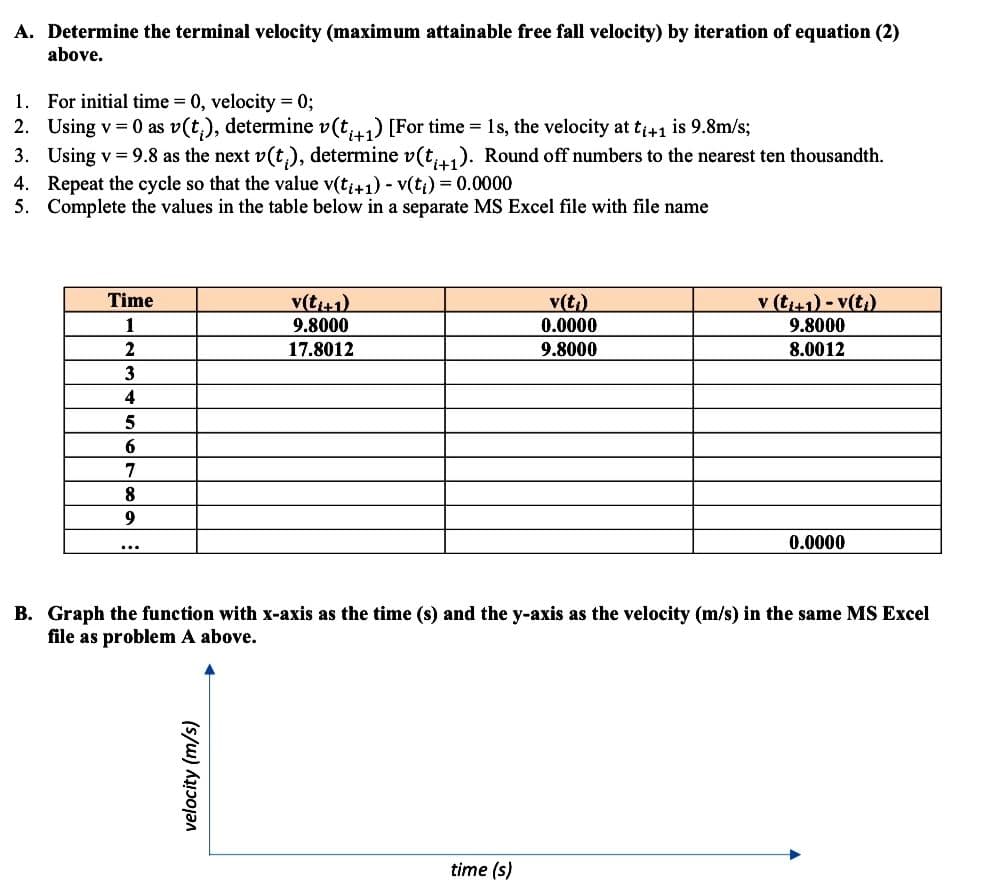Numerical Solution to the Falling Parachutist Problem: Where: DO E UD Fw=mg с Object released from rest A numerical iterative solution was formulated to be: V FD ti ti+1 Fw=mg During acceleration A parachutist of mass 68.1 kg jumps out of a stationary hot air balloon. The drag coefficient is 12.5kg/s. Given the differential equation: 9-12 v (1) g = acceleration due to gravity, 9.8 m/s² m = mass of the parachutist, 68.1 kg = drag coefficient, 12.5 kg/s = velocity, in m/s = initial time interval, in seconds = following time interval, in seconds FD=Fw=mg Fw=mg net force=Fp-Fw = mg-mg = 0 At terminal velocity v(ti+1)= v(t₁) + [g- / v(ti)](ti+1-t₁) (2)
Numerical Solution to the Falling Parachutist Problem: Where: DO E UD Fw=mg с Object released from rest A numerical iterative solution was formulated to be: V FD ti ti+1 Fw=mg During acceleration A parachutist of mass 68.1 kg jumps out of a stationary hot air balloon. The drag coefficient is 12.5kg/s. Given the differential equation: 9-12 v (1) g = acceleration due to gravity, 9.8 m/s² m = mass of the parachutist, 68.1 kg = drag coefficient, 12.5 kg/s = velocity, in m/s = initial time interval, in seconds = following time interval, in seconds FD=Fw=mg Fw=mg net force=Fp-Fw = mg-mg = 0 At terminal velocity v(ti+1)= v(t₁) + [g- / v(ti)](ti+1-t₁) (2)
Engineering Fundamentals: An Introduction to Engineering (MindTap Course List)
5th Edition
ISBN:9781305084766
Author:Saeed Moaveni
Publisher:Saeed Moaveni
Chapter8: Time And Time-related Variables In Engineering
Section: Chapter Questions
Problem 39P
Related questions
Question
100%
NUMERICAL SOLUTIONS (Upvote will be given. Please answer the problem USING MS EXCEL. No long explanation needed. Take a screenshot of the formulas and results.)

Transcribed Image Text:A. Determine the terminal velocity (maximum attainable free fall velocity) by iteration of equation (2)
above.
1. For initial time = 0, velocity = 0;
2. Using v=0 as v(t), determine v(t+1) [For time = 1s, the velocity at ti+1 is 9.8m/s;
3. Using v = 9.8 as the next v(t₁), determine v(t+1). Round off numbers to the nearest ten thousandth.
4. Repeat the cycle so that the value v(ti+1) - v(ti) = 0.0000
5. Complete the values in the table below in a separate MS Excel file with file name
Time
1
2
3
4
5
6
7
8
9
v(t₁+1)
9.8000
17.8012
velocity (m/s)
v(t₁)
0.0000
9.8000
time (s)
v (t+1)-v(ti)
9.8000
8.0012
B. Graph the function with x-axis as the time (s) and the y-axis as the velocity (m/s) in the same MS Excel
file as problem A above.
0.0000

(2)](/v2/_next/image?url=https%3A%2F%2Fcontent.bartleby.com%2Fqna-images%2Fquestion%2Fccab2a1f-3b09-4b17-913d-33f5b65cc135%2Fe6951f76-45e8-4d57-bb5c-5faf96000ee4%2Ff39d2t_processed.jpeg&w=3840&q=75)
Transcribed Image Text:Numerical Solution to the Falling Parachutist Problem:
Fw=mg
Where:
Object released from rest
m
с
V
ti
ti+1
FD
Fw=mg
During acceleration
A numerical iterative solution was formulated to be:
FD=Fw=mg
Fw=mg
A parachutist of mass 68.1 kg jumps out of a stationary hot air balloon. The drag coefficient is 12.5kg/s.
Given the differential equation:
(1)
= acceleration due to gravity, 9.8 m/s²
= mass of the parachutist, 68.1 kg
=
drag coefficient, 12.5 kg/s
= velocity, in m/s
= initial time interval, in seconds
= following time interval, in seconds
net force
=mg-mg = 0
At terminal velocity
dv
dt
Fo-Fw
m
V2
v(ti+1)= v(ti) + [g-v(ti)](ti+11 - t₁)
(2)
Expert Solution
This question has been solved!
Explore an expertly crafted, step-by-step solution for a thorough understanding of key concepts.
This is a popular solution!
Trending now
This is a popular solution!
Step by step
Solved in 2 steps with 2 images

Knowledge Booster
Learn more about
Need a deep-dive on the concept behind this application? Look no further. Learn more about this topic, civil-engineering and related others by exploring similar questions and additional content below.Recommended textbooks for you

Engineering Fundamentals: An Introduction to Engi…
Civil Engineering
ISBN:
9781305084766
Author:
Saeed Moaveni
Publisher:
Cengage Learning

Engineering Fundamentals: An Introduction to Engi…
Civil Engineering
ISBN:
9781305084766
Author:
Saeed Moaveni
Publisher:
Cengage Learning